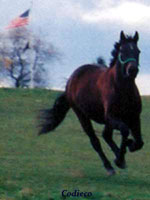
Horse Slaughter
FAQ's
Facts
Slaughter Stats
Public Opinion Polls
Press
What You Can Do!
Status of Federal Legislation
About
Who We Are
Our Horses
Support/Donations
Merchandise
Contact Us:
Links
California Voters "Just Say Neigh" to Horse Slaughter!
HoofPAC
Equine Protection Network
PayPal accepts credit cards! Please send your tax deductible donation to the:
Equine Protection Network, Inc.,
Did You Know?
No American horse-not even our old, lame, slow, untamed, or unwanted ones-should be so cruelly betrayed for 40 pieces of silver...
Cathleen Doyle
HoofPAC, Save The Horses, California Equine Council
Page last revised on:
"The greatness of a nation and its moral progress can be judged by the way its animals are treated."
Ghandi

Horse Slaughter Issue
"The Horse Slaughter Issue is about
Disposal.
How are we going to kill America's Horses.
Are we going to kill them via a method that is
repulsive to the vast majority of Americans,
a method that is against our culture - Slaughter,
or are we going to kill America's Horses via a
method
that is in line with American Culture and accepted
by Americans -
Lethal Injection. "
Christine Berry, Equine Protection
Network
November 1, 2007
EPN Response to Pro Slaughter Vet on the Issue of Horse Slaughter, the slaughter of a NON-FOOD ANIMAL!
Save America's Horses!
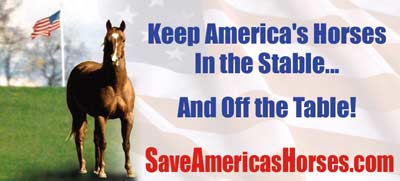
The Slaughter of America's Horses - An American Tragedy
Over 200 years ago, when America declared our independence from England, Brown Beauty and Star carried Paul Revere & Sybil Luddington on their famous midnight rides to warn the colonists that the British were coming. 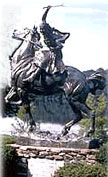
Thus began America’s love affair with horses, a love affair that continues until this day. Sadly though, during the last 25 years, over 4 and a half million of our beloved American horses have been secretly purchased, & cruelly slaughtered to satisfy a foreign taste for horsemeat.
My love affair with horses began as a small child when my days were filled with riding and caring for horses. I later turned my passion and love for horses into my career. In the early 1980’s I was horrified to learn about the cruel practice of horse slaughter and vowed that I would never send any of my horses to slaughter.
Yet it took me over 15 years before I took any action to stop the slaughter. Today I hope to persuade you to take a few minutes of your time to help me end the slaughter of America’s horses, which is an American Tragedy.
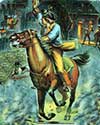 If it were not for gallant horses such as Brown Beauty and Star, American history would be profoundly different. It was the horse that enabled our forefathers to explore and settle America. It was the horse that helped to clear the forests and later plowed our fields, and then transported our products to market. It was the horse that provided sport and recreation to the early Americans via racing on ovals cut from the virgin American forest. It was the horse that provided our transportation. Horses raced our firefighters to burning homes and carried doctors to the sick and injured. It was the swift horse that carried our mail across the untamed West. It was the brave horse that carried our armies into battle, and to this day carries our fallen heroes to their final resting places.
If it were not for gallant horses such as Brown Beauty and Star, American history would be profoundly different. It was the horse that enabled our forefathers to explore and settle America. It was the horse that helped to clear the forests and later plowed our fields, and then transported our products to market. It was the horse that provided sport and recreation to the early Americans via racing on ovals cut from the virgin American forest. It was the horse that provided our transportation. Horses raced our firefighters to burning homes and carried doctors to the sick and injured. It was the swift horse that carried our mail across the untamed West. It was the brave horse that carried our armies into battle, and to this day carries our fallen heroes to their final resting places.
Every American President has been photographed with a horse, and many have been carried to our national cemetery in Arlington by the horses of the caisson platoon.
 With the onset of the industrial revolution and the mechanization of the farm many believed that the horse would depart from the American scene. Instead the horse continued to ride on into the hearts of Americans. As the car replaced the horse and the Depression spread across America it was a horse named Seabiscuit that Americans took into their hearts and called their own.
With the onset of the industrial revolution and the mechanization of the farm many believed that the horse would depart from the American scene. Instead the horse continued to ride on into the hearts of Americans. As the car replaced the horse and the Depression spread across America it was a horse named Seabiscuit that Americans took into their hearts and called their own.
Today the horse is used in America for sport, recreation, and pleasure.
- Every weekend across the United States thousands of Americans enjoy the scenic beauty of our country from the back of a horse.
- Everybody loves a parade, especially with all the pretty horses prancing down the street.
- Every summer thousands of American children spend countless hours in the company of a horse at summer camps and riding stables.
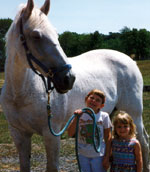
- Millions of Americans participate in competitive events involving horses including horse shows, trail rides, trick riding, vaulting and drill teams.
- Police departments use horses not only in crowd control, but for public relations.
- Horses are utilized by search and rescue teams
- Horses are used in thousands of therapeutic riding programs for handicapped children and adults.
- Advertisers use the magnificent horse to symbolize power, beauty, grace, and speed.
- Horses provide entertainment to millions of America
- American special forces soldiers even rode horses in Afghanistan.
The horse is ingrained in American culture as our partner, friend and companion-not as our next meal.
 Congress passed the Wild Horse and Burro Act in 1971 protecting our wild horses from slaughter and declaring the wild horse a living symbol of our American heritage.* (Protection revoked 12/07/04, H.R. 297 introduced in 2005 to restore protection) If Congress is to truly be the voice of the American people, and not the voice of special interests, the slaughter of American domesticated and wild horses must be stopped.
Congress passed the Wild Horse and Burro Act in 1971 protecting our wild horses from slaughter and declaring the wild horse a living symbol of our American heritage.* (Protection revoked 12/07/04, H.R. 297 introduced in 2005 to restore protection) If Congress is to truly be the voice of the American people, and not the voice of special interests, the slaughter of American domesticated and wild horses must be stopped.
We do not raise our horses in the United States for food and fiber, and we do not view our horses as food animals. When we breed our horses, we dream of the next Triple Crown winner, not our next steak dinner. It is not illegal to eat a horse in the US, yet Americans voluntarily choose not to eat horses, just as we choose not to eat our dogs and cats. The reason is really quite simple, it is not our culture.
Widespread polling in several states always reaches the same conclusion - American voters believe it is a crime to slaughter a horse for human consumption. When they learn that it is not, 88%-93% believe that the slaughter of American horses should be illegal. Americans find it offensive to eat a horse due to our culture, and it is our culture that shapes our laws.
 Only
three slaughterhouses exist today in the US, Dallas
Crown, Bel-Tex located in Texas, both foreign owned.
Cavel (a slaughter house destroyed by fire in 2002),
has rebuilt in DeKalb, Illinois.* (Slaughter
plants in the U.S. shut down due to passage
of Illinois Public Act 095-0002 an amendment to the
IL Horse Meat Law on May 24, 2007 outlawing horse slaughter in
Illinois, and the U. S.
Fifth Circuit Court of Appeals ruling upholding the legality of 1949
Texas Horsemeat Law.)Thousands of American horses
are also exported every year to
Canada and Mexico for slaughter.
Only
three slaughterhouses exist today in the US, Dallas
Crown, Bel-Tex located in Texas, both foreign owned.
Cavel (a slaughter house destroyed by fire in 2002),
has rebuilt in DeKalb, Illinois.* (Slaughter
plants in the U.S. shut down due to passage
of Illinois Public Act 095-0002 an amendment to the
IL Horse Meat Law on May 24, 2007 outlawing horse slaughter in
Illinois, and the U. S.
Fifth Circuit Court of Appeals ruling upholding the legality of 1949
Texas Horsemeat Law.)Thousands of American horses
are also exported every year to
Canada and Mexico for slaughter.
Each year thousands of American horses are purchased from unsuspecting owners or stolen and sent to a terrifying death at a slaughterhouse. Horse dealers routinely tell unsuspecting owners that their horse will have a wonderful home with green pastures and loving owners. Lesson stables and riding camps tell naive students and boarders that the unsound lesson or camp horse is on his way to a retirement farm, when in reality the horse has embarked on the last ride to the slaughterhouse.
I have always known in my heart that slaughter is the ultimate betrayal to an animal who has given their life to serve you and bring you joy. Sadly though many horse dealers, trainers and breeders are pro slaughter. How can one profess to love and admire a horse, and at the same time endorse the slaughter of these magnificent animals? The answer is simple. Those that are motivated by money support the slaughter, those that are motivated by a love for the horse are opposed to the slaughter.
 Horses travel thousands of miles with no food, no water, and no rest over a period of days in overcrowded trucks designed for cattle and hogs. The low ceilings in the trailers make it impossible for the once proud and majestic horses to even raise their heads.
Horses travel thousands of miles with no food, no water, and no rest over a period of days in overcrowded trucks designed for cattle and hogs. The low ceilings in the trailers make it impossible for the once proud and majestic horses to even raise their heads.
 Upon arrival at the slaughterhouse they are herded into a lineup where they can smell and hear the horses ahead of them being killed. Electric cattle prods or a spear type weapon is used to prod the horse into the knock box where a worker attempts to knock the horse unconscious with a 4 inch nail driven into their head. The terrified horses whose instinct is to flee, have nowhere to run and scramble and fall in desperation, slipping on the urine and blood soaked floor of the knock box. The horse is then shackled by one hind leg & hoisted into the air upside down to have their throat cut and allowed to bleed out. Some horses are still conscious when hoisted into the air.
Upon arrival at the slaughterhouse they are herded into a lineup where they can smell and hear the horses ahead of them being killed. Electric cattle prods or a spear type weapon is used to prod the horse into the knock box where a worker attempts to knock the horse unconscious with a 4 inch nail driven into their head. The terrified horses whose instinct is to flee, have nowhere to run and scramble and fall in desperation, slipping on the urine and blood soaked floor of the knock box. The horse is then shackled by one hind leg & hoisted into the air upside down to have their throat cut and allowed to bleed out. Some horses are still conscious when hoisted into the air.

The Report of the American Veterinary Medical Association's Panel on Euthanasia in 2002 did not consider this method of killing a horse, “Acceptable”. Humane euthanasia performed by a veterinarian using lethal injection is the method preferred to slaughter. Responsible horses owners euthanise their horses, they do not send them to a slaughterhouse to be beaten to death and have their throats cut.
Yet there are those in the horse industry that claim this method of death is humane. After holding many a horse euthanised by lethal injection, and viewing videos of horses killed in a slaughterhouse, there simply is no comparison. I find these claims by the American Quarter Horse Association, AQHA, the American Paint Horse Association, APhA, the American Association of Equine Practitioners, AAEP, the American Veterinary Medical Association, AVMA, and various state horse councils to be an insult to my intelligence and common sense. I believe they all are in need of a visit to the "No Spin Zone".
The AAEP claims that the captive bolt is humane euthanasia. Does that mean that when an equine practitioner is called to our horse farms we can expect to be advised that our horses are going to be humanely euthanised via the captive bolt, and make sure to have the hose ready so that we can wash away all the blood after the vet finishes the procedure by slashing our beloved horses' throats?
Of course not! This argument is ludicrous!
The AAEP is also expressing concerns over the disposal of 100,000 unwanted horses each year if slaughter is outlawed. As a horse owner should I now expect my equine vet to recommend to me that instead of euthanising my beloved horse at home, I should send them to the auction to be purchased by the killers so as not to contaminate the groundwater?
At the American Horse Council Meeting in April 2005 Dr. Nat Messer, D.V.M. showed a Power Point Presentation indicating that there were not any rendering facilities for horses in Pennsylvania. As someone who has lived in Pennsylvania for the past 20 years and who has used the services of rendering plants to pick up horse carcasses, I am confused about Dr. Messer's information. Dr. Messer also claims that the United States does not have the rendering facilities capable of handling 100,000 horse carcasses a year a statement which is contradicted by the information provided by the National Renderer's Association. We must also not forget that as a demand arises, businesses develop to meet that demand as can be demonstrated by the increase in facilities that handle private cremation for horses and burial at pet cemeteries.
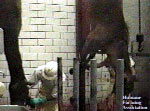 Due to the fact that we do not raise horses in America for food or fiber, veterinarians routinely prescribe and care for horses with antibiotics, performance enhancing drugs, hormones, neutraceuticals, and additional over-the-counter equine products, none of which the Food and Drug Administration, (FDA) has tested or approved for use in or on horses intended for food. Our tack room shelves are filled with products we use daily on our horses which carry this bold warning on the label, "NOT TO BE USED ON HORSES INTENDED FOR USE AS FOOD." The manufacturers of these products are not going to invest in the expensive and time consuming testing procedure to determine what is a safe withdrawal period for use on horses intended for food for one simple reason- Americans do not eat horses.
Due to the fact that we do not raise horses in America for food or fiber, veterinarians routinely prescribe and care for horses with antibiotics, performance enhancing drugs, hormones, neutraceuticals, and additional over-the-counter equine products, none of which the Food and Drug Administration, (FDA) has tested or approved for use in or on horses intended for food. Our tack room shelves are filled with products we use daily on our horses which carry this bold warning on the label, "NOT TO BE USED ON HORSES INTENDED FOR USE AS FOOD." The manufacturers of these products are not going to invest in the expensive and time consuming testing procedure to determine what is a safe withdrawal period for use on horses intended for food for one simple reason- Americans do not eat horses.
FDA Warning Letter Illegal Residue in Horsemeat
The slaughter of American horses supports the monetary motivation and disposal channels for irresponsible and indiscriminate over breeding, the dumping ground for abused and neglected horses, the factory farming of horses, consumer fraud by unscrupulous horse dealers, the illegal butchering of our federally protected wild horses, and public health and safety issues.
Our American companion, sport, and recreational horses are worthy of the same protection against slaughter as our cats and dogs which like the horse, are considered by Americans to be nonfood, companion, pleasure and recreational animals. The butchering of American horses for consumption by foreign connoisseurs could be outlawed today and it would not even create a ripple to agriculture, business or foreign trade.
There is no research to back up the pro slaughter forces claims that ending slaughter will lead to increased neglect of horses. Owners neglect horses due to irresponsibility and laziness. According to Carolyn Stull of U. C. Davis in a presentation at the American Horse Council Unwanted Horse Meeting in Washington D.C. on April 18, 2005 there has not been an increase in horse neglect cases since the passage of Prop 6 in California in 1998. According to the Hooved Animal Humane Society in Illinois, there was not an increase in neglect cases in Illinois during the two year period Cavel International was not operating.
In late 2007 and into early 2008 the pro slaughter forces have launched a campaign in the media claiming that due to a combination of the lack of slaughter facilities, the economic downturn and the increased cost of hay due to drought and reduced hay production. Reporters interviewed representatives from state horse councils and state extension offices regarding abandoned horses. These representatives stated that abandoned horses were turning up in state forests, on private farms, and livestock markets. The reporters printed these statements without any corroboration from law enforcement agencies or officials from state forest or national park agencies. State laws have require a protocol for those who have recovered an abandoned animal. Abandoned animals cannot be disposed of without following state law, yet the reporters failed to check out the statements made by these officials from the state horse councils and extension services.
A group of concerned citizens volunteered their time and resources to research this issue contacting 30 state agencies including state police, sheriffs, parks, and game commissions. The research returned no records of abandoned horses. Deleting the Fiction
Owners send horses to slaughter for one reason - Money. The cost of euthanasia and disposal is not as prohibitive as the pro slaughter forces would lead you to believe. The cost is relative to the cost of a new set of shoes, which horses receive every six to eight weeks. I can put a horse down and have the carcass removed, for less than it costs to euthanise my dog and cremate her.
In December 1775, Black Bess carried Betsy O’Dowdy across the Currituck Sound and over 50 miles inland to warn the American Army that the British were coming to slaughter their horses. The American Army knew they must stop the British advance, because they depended on the horse for their existence, and the American Revolution depended on their horses. Due to the swiftness and courage of Black Bess, the Americans were alerted & stopped the British advance. Our horses were saved.
Now it is again time for Americans to save American horses from slaughter, this time by the French and the Belgians. Please take some time from your busy schedule today and help me Save America's Horses!
Let’s put American horses back in the stable and keep our American horses off French and Belgium dinner tables!
Thank you.
Christine Berry
Equine Protection Network
EPN White Paper on Unwanted Horses in America
May 2005
PA Horse Transport Law Cards | NY Horse Transport Law Card | Vermont Horse Transport Law Card | MD Horse Transport Law Card
Download a card and carry in your car. Help enforce PA law banning the use of double deck trailers to transport any horse, no matter what its final destination!